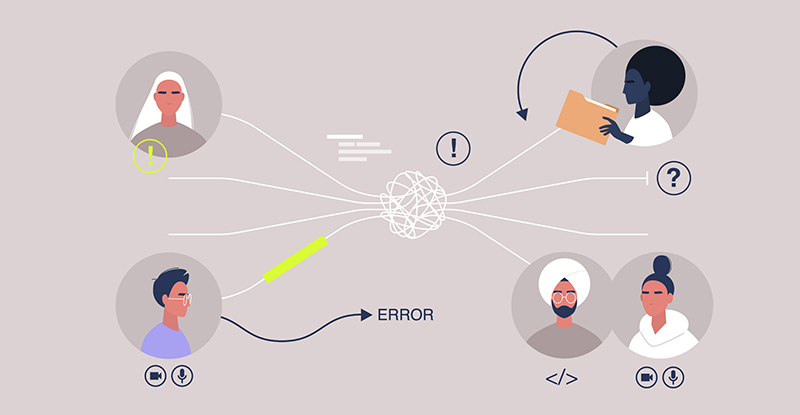
Expanding on our popular Women’s Leadership Series, our new Women's Leadership Mini-Series from October 24 - December 5, 2023 will cover new topics designed specifically for women in the accounting profession. All sessions will be held as live webinars. Learn more and register to save your spot!
Three common pitfalls and how to avoid them
How many times have you experienced a communication breakdown and wondered, “Did they misunderstand me or did I misunderstand them?” If your answer is “rarely,” well done. Still, even the most effective communicator can benefit from understanding how and why communication breaks down, because—whether you’re messaging by email or meeting in-person—there are many, many ways communication can go awry.
Here are three of the most common causes of miscommunication and some strategies to avoid them.
We make assumptions
Whenever we assume that we know what someone else is thinking or feeling, we open the door for miscommunication. Interestingly, this kind of assumptive thinking sometimes stems from a phenomenon called “closeness communication bias.” 1 This refers to a tendency to overestimate the effectiveness of our communication when engaging with someone we consider close—whether that person is a partner, a friend, or a colleague.
Astudy published in the Journal of Experimental Social Psychology 2 suggests that we assume people who are close to us will automatically know what we mean and vice versa. In reality, however, researchers found that study participants often understood strangers just as well or even better than those with whom they had close relationships.3 Why? Because when it comes to strangers, we tend to express ourselves more precisely and/or listen more carefully.
Specifically, closeness communication bias manifests when we make assumptions instead of gathering information, overestimate our shared perspective and assume a common frame of reference, and romanticize how well we actually understand one another.
The good news is that once you’re aware of closeness communication bias, you can explore strategies to mitigate its influence:
- Avoid assumptions. Are you expecting the other person to intuitively understand what you mean or to respond in a certain way? While being close to someone often means they “just get us,” it’s important to not take this closeness for granted.
- Be aware of your biases. We all hold biases and operate from different frames of reference based on our lived experiences. Be aware of how your biases show up in your communication and interaction with others. At the same time, recognize that other people have biases of their own, and ones you may not know about.
- Keep an open mind. Be aware of the expectations or judgments you’re bringing to the conversation, and be careful not to project these onto your co-communicator.
- Invite feedback. After sharing information, it can be helpful to pause and let the person you’re communicating with ask questions or provide a response. It can also help to ask open-ended questions like “What do you think?” and “What else do you want to know?” And it’s important to listen without interrupting or leading them to a certain conclusion.
We under-communicate
One of the most common ways we miscommunicate is by not communicating enough. In fact, most people and organizations are guilty of under-communicating. Whether intentionally or not, we often:
- Assume people don’t need or want to know something;
- Overestimate how much other people already know; and/or
- Feel the need to protect or withhold information.
Under-communicating leads people to fill in the gaps with their own assumptions. This can cause all sorts of communication breakdowns and trigger rumours and gossip. It can also weaken engagement, as people tend to disengage when they feel excluded from the conversation.
On the other hand, keeping people well informed can help spark connections, inspire innovation, and build trust. People feel valued when they are included and kept “in the know.”
In reality, if you want someone to truly understand you or absorb the information you have to impart, you need to over-communicate. To this end, repetition is one strategy to consider. When it comes to sharing information and helping your audience understand and retain your message, saying it again and again—and sometimes again—can be essential.
We lack clarity
Effective communication should be clear and concise (see PD Experts on pages ##-## for more on this topic). A lack of clarity in your communication can cause confusion, misunderstanding, and inertia. Here are some ways to crystallize your message:
- Define your goal. If you’re not sure of your goal, you can’t articulate it clearly.
- Aim for short, direct sentences. Saying less forces you to focus, and a sharper focus leads to greater clarity. Be sure to state exactly what it is you want people to understand and what, if anything, you’re asking them to do.
- Put yourself in your co-communicator’s shoes. What’s in it for them? Are you planning to share information that will help them take specific action? Are you seeking information from them, so you can take action that could help ease their load? Or are you simply looking to strengthen your connection? Ask yourself what’s in it for the other person, and then make sure your communication delivers.
- Refine your message. Even when you’re planning a quick phone call, it can help to write down your message first. What’s the purpose of your call? What wisdom do you want to acquire or impart?
- Take a break. When planning your communication, it can help to walk away, do something else, and come back. Does your message still make sense? Is it necessary? Does it still add value? If you’re unsure, ask a colleague for feedback.
Focus on the things you can change
Ultimately, when it comes to communication, we can’t control what other people hear or how they interpret us—no matter how hard we try. Thankfully, however, a little thought, care, and awareness can go a long way to helping us strengthen our understanding of one another and avoid communication breakdowns.
Corinne Impey is the founder of and director of communication for Six Words Communication Corp., headquartered in Vancouver. Together with her team, she provides strategic communication, change management, and marketing services to companies and organizations championing social and environmental change and innovation. You can also find free communication tips from her team on the company's blog.
This article was originally published in the January/February 2022 issue of CPABC in Focus.



